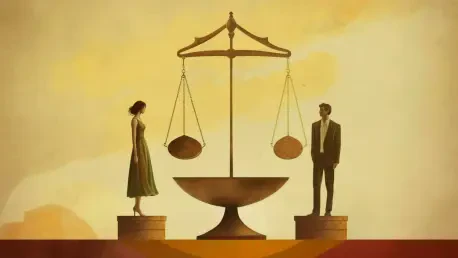In the heart of Nepal, a nation steeped in rich traditions and complex social hierarchies, a fierce debate unfolds over the very fabric of its legal system, highlighting the intense struggle between modern ideals and longstanding customs. Imagine a society where laws on marriage, divorce, and personal rights are being reshaped, sparking outrage and confusion among citizens who grapple with the clash between modern ideals of fairness and deeply rooted traditions. This tension between gender equality, which seeks uniform rights for all, and cultural protections, which aim to safeguard vulnerable groups through tailored measures, lies at the core of recent legal reforms. As Nepal navigates this delicate balance, the struggle reflects a broader global challenge: how to honor universal human rights while preserving unique societal values. This comparative analysis delves into these competing principles, exploring their implications in a nation at a crossroads of tradition and progress.
Understanding the Core Concepts and Their Context
Gender equality stands as a universal ideal, advocating for equal rights, opportunities, and treatment regardless of gender, often rooted in international human rights frameworks. It pushes for laws and policies that eliminate discrimination, ensuring that men and women face the same legal standards and societal expectations. This principle has gained traction globally, influencing reforms that aim to dismantle systemic biases and promote fairness in areas like marriage, employment, and personal freedoms.
In contrast, cultural protections prioritize the preservation of traditional norms and localized practices, often designed to shield specific groups from systemic disadvantages. In many societies, including Nepal, these protections manifest as affirmative action, offering specific safeguards for women in patriarchal structures where historical inequities persist. Such measures are seen as essential to address vulnerabilities that gender-neutral laws might overlook, focusing on equity rather than strict equality.
The relevance of these concepts is particularly pronounced in Nepal, where legal and social frameworks are shaped by a blend of historical customs and modern aspirations. Family law, marriage, and gender roles are deeply influenced by cultural heritage, often drawing from Hindu jurisprudence and customary practices. As the nation evolves, the push for gender equality through legal amendments clashes with the desire to maintain protections that reflect Nepal’s unique identity, creating a complex backdrop for policy debates and societal change.
Key Areas of Comparison Between Gender Equality and Cultural Protections
Legal Frameworks and Policy Approaches
Gender equality in legal systems often translates to gender-neutral laws, aiming for identical treatment under the law. In Nepal, recent amendments to the Criminal and Civil Codes exemplify this approach, with proposals to equalize penalties for polygamy and polyandry, ensuring that both men and women face the same consequences for multiple marriages. Such reforms are driven by constitutional mandates for equality, seeking to eliminate gender-specific distinctions in legal accountability.
On the other hand, cultural protections advocate for policies that recognize inherent societal disparities, often through affirmative action. In Nepal’s family law, this is evident in safeguards designed specifically for women, acknowledging their unique challenges in a male-dominated society. For instance, traditional provisions have focused on protecting women’s rights in marriage and divorce, prioritizing their security over uniform legal standards, which highlights a fundamental divergence from the equality-driven model.
A striking example of this tension appears in Nepal’s redefinition of rape laws. Under equality-focused reforms, the law now includes women as potential perpetrators, aligning with a gender-neutral stance. However, cultural protections argue for maintaining a focus on women’s vulnerabilities, given the societal context where power imbalances heavily favor men, illustrating how legal frameworks under each approach can yield vastly different outcomes in addressing gender-based issues.
Societal Impact and Real-World Equity
The societal impact of gender equality initiatives often centers on creating a level playing field, but their effectiveness in achieving true equity can be limited by entrenched disparities. In Nepal, while gender-neutral laws aim for fairness, they may fail to address the practical realities of a patriarchal society where women face systemic barriers. Legal equality, such as equal penalties for marital offenses, does not always translate to equitable outcomes when social and economic power imbalances remain unaddressed.
Cultural protections, by contrast, strive to tackle these disparities head-on by prioritizing equity over equality. In Nepal, measures like specific rights for first wives in bigamy cases are intended to empower women within the constraints of existing social structures. However, such protections can sometimes be misinterpreted or misused, as seen in public confusion over bigamy clauses, where the intent to safeguard women is overshadowed by perceptions that the law endorses polygamy, revealing gaps between policy goals and societal understanding.
This disconnect underscores a broader challenge in measuring real-world impact. While gender equality pushes for uniform standards, it risks ignoring contextual inequalities that hinder fair outcomes. Meanwhile, cultural protections, though tailored to specific needs, can struggle to adapt to changing societal norms, often leaving both approaches vulnerable to criticism for not fully bridging the gap between legal intent and lived experiences.
Alignment with Cultural Identity and Global Standards
Gender equality frequently aligns with international human rights norms, advocating for modernization and universal application of rights. In Nepal, this is evident in legal reforms inspired by global standards, pushing for changes in laws on sexual consent and abortion to reflect broader principles of individual autonomy. Such alignment often positions equality as a progressive force, aiming to bring national policies in line with worldwide expectations of fairness and justice.
Cultural protections, however, emphasize the importance of local traditions and identity, often drawing from indigenous customs and religious influences. Nepal’s legal system, with its roots in Hindu jurisprudence and customary laws, reflects this priority through measures that safeguard vulnerable groups within a culturally specific framework. For example, debates over abortion limits and sexual consent laws highlight a desire to protect societal values, even when they conflict with global norms, creating a distinct approach to justice.
The tension between these perspectives is palpable in Nepal’s ongoing reforms. Balancing international standards with local traditions remains a significant challenge, as seen in discussions over extending abortion limits for specific cases like rape or incest. While equality-driven reforms seek universal rules, cultural protections aim to preserve contextual sensitivities, often leading to heated debates over how best to honor both global commitments and national heritage in shaping legal and social policies.
Challenges and Limitations in Implementation
Implementing gender equality initiatives encounters substantial obstacles, particularly in societies with deep-rooted traditional values. In Nepal, resistance from patriarchal structures often undermines gender-neutral laws, as cultural norms continue to prioritize male dominance in family and social spheres. This opposition can render legal reforms ineffective, failing to alter underlying attitudes that perpetuate discrimination.
Moreover, the push for equality sometimes risks overlooking systemic inequalities that require targeted intervention. In Nepal, laws designed to treat all genders identically may not account for the historical disadvantages faced by women, such as limited access to resources or decision-making power. This gap highlights a critical limitation: without addressing contextual barriers, gender equality in law may remain a theoretical ideal rather than a practical reality.
Cultural protections, while addressing specific disparities, also face significant hurdles. There is a danger of perpetuating outdated norms that hinder broader progress toward equality, as critics in Nepal argue over retaining gender-specific safeguards in family law. Additionally, such measures can be seen as reinforcing stereotypes or limiting individual freedoms, creating friction with modern aspirations for a more inclusive society. Both approaches share common issues, including public misinformation and a lack of engagement with legislative nuances, as evidenced by social media-driven outrage over recent amendments, which complicates the effective rollout of either framework.
Conclusion and Path Forward
Looking back, the comparative exploration of gender equality and cultural protections revealed a nuanced struggle to balance universal rights with contextual realities in Nepal. Each approach carried distinct strengths—equality offered a vision of uniform fairness, while protections addressed specific societal disparities—but both grappled with limitations in implementation and public perception. The journey through legal frameworks, societal impacts, and cultural alignments underscored the complexity of reforming deeply personal laws in a traditional society.
Moving ahead, a hybrid framework emerged as a viable solution, one that could integrate the principles of gender equality with tailored cultural protections. Nepal’s legal reforms could benefit from blending these ideals, ensuring that universal rights are upheld while specific measures safeguard vulnerable groups against systemic inequities. Crafting such a balanced approach would require careful consideration of both global standards and local customs to avoid sacrificing progress or identity.
Beyond policy design, a critical step involves enhancing public education to bridge the divide between legislative intent and societal understanding. Initiatives to foster informed discourse, perhaps through community dialogues or accessible legal explanations, could mitigate misinformation and encourage broader engagement with complex issues. By prioritizing nuance over sensationalism, Nepal could pave the way for gender and cultural policies that resonate with its people, setting a precedent for other nations navigating similar tensions between tradition and modernity.









